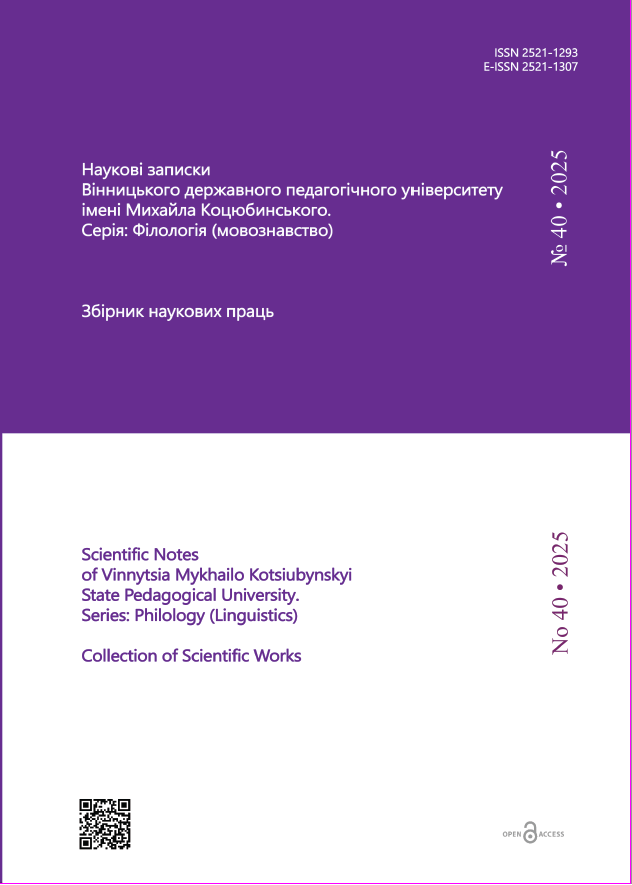Semantic aspects of translation: English-Ukrainian correspondences
https://doi.org/10.31652/2521-1307-2025-40-15Published 2025-07-07
Keywords
- emantic approach, translation studies, semasiological method, semantic equivalence, English-Ukrainian translation

This work is licensed under a Creative Commons Attribution 4.0 International License.
How to Cite
Abstract
This article offers a comprehensive examination of the semantic dimension of translation, with a particular focus on English-Ukrainian correspondences. It investigates the linguistic, cognitive, and cultural parameters that shape the process of meaning transfer across languages. The relevance of the study lies in the growing demand for precise and culturally attuned translation within an increasingly globalized communicative environment, where accurate intercultural mediation is essential in such domains as diplomacy, science, business, education, and mass media. The primary objective is to elucidate the mechanisms by which semantic relationships are realized in English-Ukrainian translation and to identify strategies that effectively ensure semantic equivalence. The study also classifies types of semantic correspondence and analyzes instances of semantic divergence, with particular attention to the interaction among lexical semantics, contextual meaning, and culturally embedded knowledge – all of which present significant challenges to translation adequacy and equivalence. Methodologically, the research employs a combination of comparative, componential, and semantic field analyses, applied to a corpus of examples drawn from literary, journalistic, and colloquial texts. The theoretical framework integrates insights from both classical and contemporary translation theories, including dynamic and formal equivalence models, as well as cognitive and functional approaches to meaning construction and transfer. The findings demonstrate that English-Ukrainian semantic correspondences are seldom isomorphic, due to substantial discrepancies in lexical organization, semantic categorization, and idiomatic expression between the two languages. While some lexical items exhibit direct equivalents, many others require contextual reinterpretation or transformation. Particular emphasis is put on the translation of polysemous words, idiomatic expressions, and culturally specific elements, which often necessitate the use of functional analogues, descriptive reformulations, or compensatory techniques to preserve both semantic content and stylistic nuance. The study further systematizes key types of semantic transformation – including generalization, concretization, modulation, and semantic development – and underscores their critical role in addressing semantic and cultural asymmetries. Special attention is given to the translation of connotative meanings and culturally loaded references, which demand not only linguistic proficiency but also advanced intercultural awareness and pragmatic sensitivity on the part of the translator. In conclusion, the article contends that translation should not be conceptualized as a mechanical process of linguistic substitution, but rather as a complex act of intercultural communication. Semantic adequacy depends on a nuanced understanding of both source and target languages, along with their respective cultural and communicative contexts. The research contributes to the advancement of translation studies by offering a refined typology of semantic correspondences, methodological guidance for semasiological analysis, and pedagogical recommendations for translator training. The implications extend to improving translation quality, enhancing intercultural competence, and informing the development of more sophisticated theoretical and practical models in translation scholarship.
Downloads
References
- Bassnett-McGuire, S. (2002). Translation Studies. London, New York : Routledge. (in English).
- Catford, J.C. (1965). A Linguistic Theory of Translation. An Essay in Applied Linguistics. Oxford : Oxford University Press. (in English).
- Cortés, O.С., Harding, S.-A. (2018). Introduction: Translation and culture. The Routledge handbook of translation and culture. Ed. by S.-A. Harding, O. C. Cortés. London, New York: Routledge, pp. 1–13. (in English). DOI: https://doi.org/10.4324/9781315670898-1
- García, A.M., Muñoz, E., Singer, N. (2023). Cognitive translation and interpreting studies in the early twenty first century. Translation, Cognition & Behavior, vol. 6(2). pp. 109–117. (in English). DOI: https://doi.org/10.1075/tcb.00081.gar
- Halverson, S. (2017). Developing a cognitive semantic model: Magnetism, gravitational pull and questions of data and method. Empirical translation studies: New methodological and theoretical traditions. Ed. by G. de Sutter, M.-A. Lefer, I. Delaere. Berlin, New York: Mouton, pp. 9–45. (in English). DOI: https://doi.org/10.1515/9783110459586-002
- Newmark, P. (1981). Approaches to translation. Oxford : Pergamon Press. (in English).
- Nida, E.A., Taber, Ch.R. (1982). The Theory and Practice of Translation. Leiden : E.J. Brill. (in English). DOI: https://doi.org/10.1163/9789004669147
- OED: Oxford English Dictionary. (2009). Second Edition on CD-ROM. Oxford : Oxford University Press, vers. 4.0. (in English).
- Papadakis, N.M., Aletta, F., Kang, J., Oberman, T., Mitchell, A., Stavroulakis, G.E. (2022). Translation and cross-cultural adaptation methodology for soundscape attributes – A study with independent translation groups from English to Greek. Applied Acoustics, vol. 200, article 109031. (in English). DOI: https://doi.org/10.1016/j.apacoust.2022.109031
- Reiß, K., Vermeer, H.J. (2013). Towards a General Theory of Translational Action. Skopos Theory Explained. London, New York : Routledge. (in English). DOI: https://doi.org/10.4324/9781315759715
- Sperber, A.D., Devellis, R.F., Boehlecke, B. (1994). Cross-Cultural Translation: Methodology and Validation. Journal of Cross-Cultural Psychology, vol. 25(4), pp. 501–524. (in English). DOI: https://doi.org/10.1177/0022022194254006
- Vandevoorde, L. (2020). Semantic Differences in Translation. Exploring the field of inchoativity. Berlin: Language Science Press. (in English).





